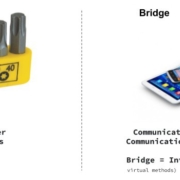Bridge Design Pattern is a Structural Design Pattern used to decouple a class into two parts — abstraction and it’s implementation — so that both can be developed independently. This promotes the loose coupling between class abstraction and its implementation. You get this decoupling by adding one more level of indirection i.e. an interface that acts as a bridge between your original class and functionality. Insulation is another name of the Bridge Design Pattern in the C++ world.
"All problems in computer science can be solved by another level of indirection." — David Wheeler



